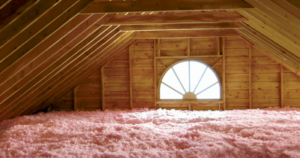If you ever go into your attic during the summer months, you know that it is sweltering up there. If the attic has poor insulation, this heat can travel down to other areas of your house, increasing the overall temperature and affect energy efficiency. Attic insulation works to keep the heat in your attic so that you can save money on cooling bills.
Insulating an Unfinished Attic
Contents
You can use any type of insulation in an unfinished attic; the key is to add insulation to all walls as well as to the floor and ceiling. As you are adding insulation, make sure that you keep any electrical equipment, ducts, and pipes clear. You will want to ensure a proper seal for these areas. To seal the entryway of your attic, use weather stripping; this will prevent hot air from escaping around the attic door and getting into the rest of your home.
 Insulating a Finished Attic
Insulating a Finished Attic
Like any other living space, a finished attic needs to be temperature-controlled to stay comfortable—insulating it will help with this. If your attic is half living space and half unfinished, you want to put equal focus on each. It will be easier to insulate the unfinished part since there is no drywall to contend with. Simply add the insulation as you would to any other wall before finishing it. In a completely finished space, concentrate on the knee (short) walls since you likely do not want to have to remove all of the drywall to check the insulation.
Attic Insulation Techniques
Batts and blankets are easy to use because you simply lie them down and staple them into place. When you lay this type of insulation, start in one corner of your attic and work to the other side so that you do not miss anything. As you work, cut the pieces of insulation to fit flush with the floor and walls.
Loose-fill insulation requires a blower. With this type of insulation, you want to start with the joists and small areas to ensure proper filling. After completing these, you want to blow the insulation around the rest of the attic—be careful not to cover any heating and cooling vents.
As you’re insulating your attic, make sure that you are mindful of ventilation. It is important that the hot air is able to escape isn’t trapped inside of the walls by the insulation. Rafter vents work best to ensure adequate insulation.
It is important to check your attic insulation at least once a year—preferably in spring, so that if you need to add more, you can get it finished before the summer weather becomes too extreme. This reduces the cost it takes to air condition your home and ensures ultimate living comfort. Proper insulation will also keep you warmer once the winter hits, so you want to keep an eye on your insulation throughout the year.
Trust in PFO
Princeton Fuel is the area’s leader in providing inexpensive, reliable and safe generators, heating oil and HVAC solutions—giving your home and business ultimate comfort all year long.



